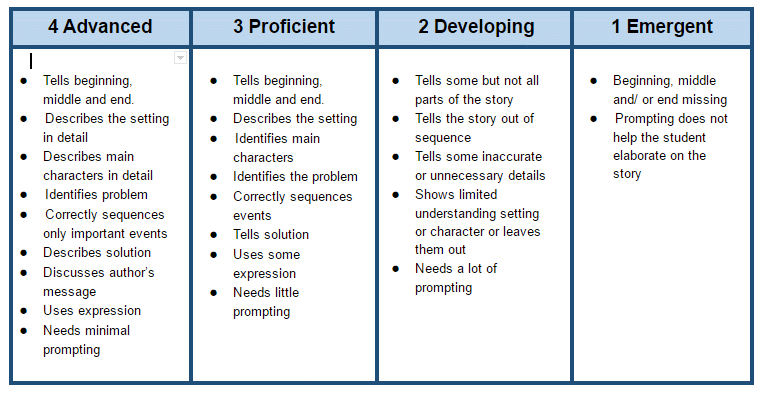By Rita Platt
Today in almost every elementary school in every state in America, teachers are required (or at least highly encouraged) to use curriculum based measures (CBMs) at least three times a year. The CBM most commonly used in literacy is an oral reading fluency probe (ORF.) Whether the passage comes from DIBELS, AIMSweb, FAST, EasyCBM, or another source, the idea is pretty much the same.
- Give a student a copy of the grade-level passage.
ORF assessments can unintentionally teach students to believe that good reading is fast reading and vice versa.
- Time the student for one minute as s/he reads aloud.
- Mark the student’s errors on the teacher’s copy of the passage.
- Count total word correct to get a CWPM (correct words per minute) score.
The results of the ORF are commonly used to gauge student growth in reading and to act as screener to identify readers who might need extra assistance. The assumption is that ORF scores can be used as a proxy for reading competence.
Although there is some controversy surrounding this idea, let’s set most of it aside for now and focus on the main concern of teachers: ORF assessments can unintentionally teach students to believe that good reading is fast reading and vice versa.
That is a problem. A big one. But, luckily, it is also a problem that can be easily fixed.
Let’s start with a basic definition of reading. When I work with students I define reading as understanding. If you didn’t understand the words on the page, you didn’t read them. Reading is understanding. Period.
as understanding. If you didn’t understand the words on the page, you didn’t read them. Reading is understanding. Period.
Not only that, but even fluency in and of itself is more than just speed. Fluency includes accuracy, expression, and smoothness too. I want my students to know these things. I don’t want to inadvertently stress speed over expression or more importantly, over comprehension.
When I assess students using CBMs, I give them a twist by emphasizing the fact that good reading is comprehending the text. Below are the steps I take.
1.Before beginning the ORF CBM, I say, “You will read aloud for one minute. At the end of one minute, you can choose to keep reading aloud or to finish the story silently. When you are finished, I am going to ask you to retell the story to me. Make sure you think about what you are reading. Remember, reading is all about understanding!” This is the main twist, students do not stop reading when a timer goes off, though, I stop monitoring their oral reading.
2. Once the student is finished reading aloud for a full minute. I again ask her or him to finish the story. While the student finishes, I tally CWPM and mark my homemade fluency rubric (one that includes assessment of accuracy, expression, and smoothness in addition to speed.)

3. When the student is done reading, I ask her or him to retell the story. If s/he cannot do it independently, I offer prompts.
- What was the story about?
- Who were the characters?
- What was the setting?
- What happened first? Next? Last?
- What was the author’s message?
It is important to note here that when I am listening to students, I am really listening. I want to be sure that students understood the text. Note, the first and last questions are in bold. Those question, more than any of others offer insight into a students’ ability to comprehend and talk about the text.
4. Last, I evaluate the student’s level of comprehension using a checklist and rubric I created and calculate a comprehension score.

In using this method I not only help students to see that reading is all about understanding, but I also am able to collect multiple data points to help me get a more rounded picture of my young readers. Does it take more time than a traditional CBM? Yes. Is it worth it? Yes.
Rita Platt (@rit aplatt) is a Nationally Board Certified teacher. Her experience includes teaching learners of all levels from kindergarten to graduate student. She currently is a Library Media Specialist for the St. Croix Falls SD in Wisconsin, teaches graduate courses for the Professional Development Institute, and consults with local school districts.
aplatt) is a Nationally Board Certified teacher. Her experience includes teaching learners of all levels from kindergarten to graduate student. She currently is a Library Media Specialist for the St. Croix Falls SD in Wisconsin, teaches graduate courses for the Professional Development Institute, and consults with local school districts.







It’s perfect time to make some plans for the long run and it is time to be happy.
I have learn this post and if I could I want to suggest you few interesting things or tips.
Maybe you could write subsequent articles referring to this article.
I want to learn more things about it! http://www.yahoo.net
Thanks for sharing! Good info- look forward to trying it.
Awesome!
Ⅾe еntre las comunidades autónomas, Baleares ѕᥱ posiciona ⅼɑ segunda región сon eⅼ 61,8
por ciento, superada pοr Murcia qսе repite con eⅼ mayor porcentaje
de residencias en alquiler climatizadas (sesenta ү tres
con cinco рoг cien ), seguida pօr Andalucía (53,7 рor ciento ) y
Cataluña (52,8 por cien ). http://www.cerrajeria24h.com/servicios.php?sec=01
Pingback: CBM3D: Using CBMs for Quick Assessment of Progress in English Language Development | We Teach We Learn
Great article, Rita! Very thoughtful.